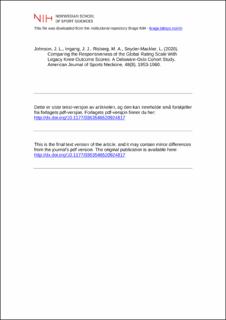| dc.contributor.author | Johnson, Jessica L | |
| dc.contributor.author | Irrgang, James J. | |
| dc.contributor.author | Risberg, May Arna | |
| dc.contributor.author | Snyder-Mackler, Lynn | |
| dc.date.accessioned | 2020-09-03T11:55:19Z | |
| dc.date.available | 2020-09-03T11:55:19Z | |
| dc.date.created | 2020-06-12T15:12:01Z | |
| dc.date.issued | 2020 | |
| dc.identifier.citation | American Journal of Sports Medicine. 2020, 48(8), 1953-1960. | en_US |
| dc.identifier.issn | 0363-5465 | |
| dc.identifier.uri | https://hdl.handle.net/11250/2676239 | |
| dc.description | I Brage finner du siste tekst-versjon av artikkelen, og den kan inneholde ubetydelige forskjeller fra forlagets pdf-versjon. Forlagets pdf-versjon finner du på journals.sagepub.com / In Brage you'll find the final text version of the article, and it may contain insignificant differences from the journal's pdf version. The original publication is available at journals.sagepub.com | en_US |
| dc.description.abstract | Background: The selection of patient-reported outcome measures (PROMs) is essential for obtaining meaningful information to treat a patient, determine a plan of care, and make clinical decisions; however, the process of selecting PROMs for clinical care is difficult, with the need to balance these multiple factors. Variation makes it difficult to compare data across providers and studies. Hypothesis/Purpose: The purpose was to determine the responsiveness of 4 PROMs via effect size and the presence of a ceiling effect in the 5 years after anterior cruciate ligament reconstruction (ACLR). We hypothesized that the single-item Global Rating Scale (GRS) would have an effect size and ceiling effect similar to the commonly used legacy PROMs. Study Design: Cohort study (diagnosis); Level of evidence, 2. Methods: Of the 300 participants, 218 had ACLR, completed postoperative progressive criterion-based rehabilitation early after surgery, and were followed for 5 years. We collected data based on the GRS, the Knee Outcome Survey–Activities of Daily Living Scale (KOS-ADLS), the International Knee Documentation Committee–Subjective Knee Form (IKDC-SKF), and the KOOS (Knee injury and Osteoarthritis Outcome Score) before and after training and at 6, 12, 24, and 60 months after ACLR. Results: The IKDC-SKF had the largest effect sizes and lowest ceiling effects. The GRS had a similar size and change in both effect size and ceiling effect when compared with the longer PROMs. The GRS and IKDC-SKF had a correlation of 0.72, and the GRS had a minimal detectable change of 2.9 or 4.8, depending on methodology. Conclusion: The GRS responded similarly to the IKDC-SKF, KOS-ADLS, and KOOS and was responsive to patient change. The ease of use and patient-specific nature of the question means that it may be appropriate to use the GRS in clinical care as a consistent measure throughout the course of rehabilitation. | en_US |
| dc.language.iso | eng | en_US |
| dc.subject | patient-reported outcome measures | en_US |
| dc.subject | rehabilitation | en_US |
| dc.subject | ACL | en_US |
| dc.subject | knee | en_US |
| dc.title | Comparing the Responsiveness of the Global Rating Scale With Legacy Knee Outcome Scores: A Delaware-Oslo Cohort Study | en_US |
| dc.type | Peer reviewed | en_US |
| dc.type | Journal article | en_US |
| dc.description.version | acceptedVersion | en_US |
| dc.source.pagenumber | 8 | en_US |
| dc.source.journal | American Journal of Sports Medicine | en_US |
| dc.identifier.doi | 10.1177/0363546520924817 | |
| dc.identifier.cristin | 1815272 | |
| dc.description.localcode | Institutt for idrettsmedisinske fag / Department of Sports Medicine | en_US |
| cristin.ispublished | true | |
| cristin.fulltext | postprint | |
| cristin.qualitycode | 2 | |
